Abstract
Tailings from metalliferous ore processing are stored in tailing-storage facilities. Fresh tailings contain high content of water, and this may contribute to the instability of the facilities. One way of depositing tailings into the facilities is to lay a layer of fresh tailings on top of previously deposited tailings and let the newly deposited tailings settle down for some time before another layer is laid. This paper utilises GeoStudio’s software packages SEEP/W, SLOPE/W, and SIGMA/W to analyse the effects of such deposition processing on the stability of a tailing dam. It is found that, generally, as more layers are added, the factor of safety of the upstream slope surface of the dam embarkment increases, while the factor of the safety of the downstream slope surface is not affected. The thickness of the layers does not affect the factor of safety of the downstream slope surface. The factor of safety of the upstream slope surface is affected by the thickness of the layers: the thicker the layers, the higher the factor of safety. Hydraulic conductivity is one of the factors that influence the settlement times of the deposited tailing layers.
1. Introduction
Tailings are produced during extraction of valuable minerals from the ores. Normally, they are considered as waste, but recently, it has been suggested that they can also be useful resources due to their possession of valuable minerals [1], their utilization in geo-products and construction materials (for example, used as sand and material for bricks, [1,2]), and possibility of using them as a sink for carbon sequestration [1,3].
At the laboratory scale, such utilizations have been proven to be successful. But due to technological limitations, the extraction of residual valuable minerals at a commercial scale is still a challenge. Similarly, the utilization of tailings materials for value-added products is also shown to be promising at the laboratory scale, but their commercial use is not a viable option due to the logistic challenges—long distance from sources of tailing to urban areas where the mass products are consumed. Nevertheless, tailings have been used locally as the construction materials of embankment of tailings storage dams and mine roads. The recent use of the tailings dam for carbon sequestration seems to be promising [1,3].
Until the technologies are fully embraced for the commercial utilization of the tailing materials, it still requires that tailings be stored in storage facilities, particularly in tailing dams. Figure 1 shows various factors involved in a tailing dam [4]. There have been many tailings-dam failures costing many human lives, bio-environments, and a large amount of infrastructure. So, the stability of the tailings dams is very important. To maintain tailing-dam stability, detailed understanding of the hydromechanical behaviour of tailings materials, monitoring, and long-term management of the dams are necessary.
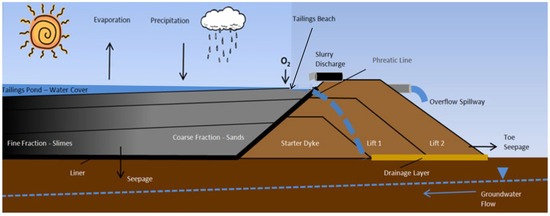
Figure 1.
Various factors involved in a tailings dam (modified from The International Network for Acid Prevention [4]).
Normally, liquefaction, seepage, piping, erosion, overtopping, foundation failing, and dam slope instability are common types of tailings-dam failure. These failures are triggered by a low factor of safety of facilities, non-favourable tailings-material properties (for example, high compressibility, low permeability, low shear strength, slow rate of consolidation, water-retaining capability, high fluid flow conductivity, low bearing capacity), high pore water pressure, and various environmental factors (rainfalls, seismicity activities, etc.) [5]. The non-favourable tailings-material properties can be associated with particle size distribution, density, cohesion, angle of friction, permeability, void ratio, moisture content, and compressibility at various scales of the tailing materials [6].
Performances of tailings dams have been investigated by many researchers with various methods, including experiments, field monitoring, and theoretical analyses. Ma and Zhang [7] presented a comprehensive review of physical experimental tests conducted on tailings dams in China up to 2017. The experiments covered four main aspects: (1) dam break mechanisms, (2) stability evaluation, (3) downstream evolution, and (4) dam protection and reinforcement.
A review paper by Clarkson & Williams [8] covers some of the practices and regulations of some countries for monitoring tailing storage facilities (TSFs). The parameters monitored include phreatic surface/water level, seepage flow, movement/displacement of materials both on surface and in the interior, pore pressure, uplift pressure, temperature, seismicity, weather, ancillary interaction, and chemicals/biological substances. Clarkson et al. [9] presented a paper with some real-time monitoring.
Due to the non-linearity of the tailings properties and complexity of tailings-storage-facility structure, closed-form or analytic investigations of tailings-dam stability are very limited. Nevertheless, an approximate limit equilibrium method (LEM) has been used in GeoStudio software SLOPE/W for studies of tailings-dams’ stability [10]. On the other hand, numerical modelling or numerical simulation becomes a vital tool for studies of tailing-dam stability, and there are many commercial software programs for this purpose, using finite difference methods (FDMs) or finite element methods (FEMs). With numerical investigations, constitutive relation for tailing materials is required. There are several constitutive models for tailing material, such as Finn–Byrne model [11,12,13,14] and UBCSAND model [15], most of them based on theories for sand. Figure 2 lists some software and constitutive models that have been used in studies of tailings.

Figure 2.
Software and constitutive models used in tailings studies.
Geppetti et al. [6] conducted a comprehensive review encompassing 15 papers centred on numerical simulations of tailing-dam dynamics. These studies predominantly employed one-dimensional or two-dimensional models, utilizing FDM (FLAC) and FEM (PLAXIS, SIGMA/W, and QUAKE/W). The constitutive models used, such as Finn–Byrne, SANISAND, and UBCSAND, were specifically for analysing liquefiable soils or sands. Many of these papers incorporated seismic loading conditions, with the Finn–Byrne model specifically tailored for examining sand behaviour under seismic stress.
Recently, a lot of research has been focusing on numerical simulation studies on the progressive sedimentation process of tailings dams [16,17,18,19,20,21]. As an example, Nguyen and Pabst [21] simulated sequential deposition of tailings using PLAC3D software with continuous update of material properties. One of their observations is that while continuously updating stiffness and hydraulic conductivity compared to fixed properties, the rate of consolidation can vary [21]. This shows the complexity involved in modelling the behaviour of tailings dams to represent the field monitoring of tailings behaviour.
Tailings could be deposited into the tailing dams in various ways. One way is to convey the slurry tailings through a pipe from the processing plant to the storage dam, discharge the tailings from the pipe into the dam, and let the tailings flow/move to the other parts of the dam basin. In this way, a layer of tailings is formed on top of tailings previously deposited [22]. When the newly deposited tailing layer settles down, another layer can be deposited. Knowing the settlement time of the tailing layers, after which water movement does not vary much, is very important for the management of tailing dams. The thickness of the layers and the properties of the tailings would affect the stability and performance of tailing dams. Such effects should be considered in tailing management. In this paper, a numerical modelling approach is used to understand the effects. Since the values of property parameters of the previously laid layers are not available, some proportional ratios are used to specify the values of their properties.
2. Numerical Model Development
GeoStudio 2024.2.1 [23] software SEEP/W, SLOPE/W, and SIGMA/W were used to model the layered tailings deposition process as described by Williams et al. [22] and to investigate its consequence in the modelled tailings-dam stability. SEEP/W modelling provides understanding of groundwater flow in saturated and unsaturated porous media using FEM, whereas the SLOPE/W provides a stability analysis of soils and rock slopes using LEM. SIGMA/W studies the stress and deformation behaviour of geo-materials using FEM. The geometry, material properties, and boundary conditions of a basic model are discussed below.
2.1. Geometry of Model
For the simulations, the tailings-dam dimension and deposition information were referred from Williams et al. [22]. A 2D sketch of the tailings deposition in a dam is shown in Figure 3. With the focus being on the effects of the deposited tailings on the stability of the dam, two major groups of materials were considered: (1) the dam material covering the embarkment and the old deposited and settled tailings (green part in Figure 3) and (2) tailing materials representing the considered deposited tailings (the grey layers at the top of dam basin). The simulated dam material region has a length of 120 m at the bottom and a height of 30 m at the left side. The top isosceles trapezoidal part of the dam material region has a height of 4.0 m, a top width of 4.0 m, and a bottom width of 16 m (leading to 33.7 degrees for the left and right slopes). The top surface of the basin has a slope of around 3.3%. Williams et al. [22] has noted that the cyclic deposition of 0.3 m thick tailings with at least 4 weeks between the deposition cycles allows the tailings to settle, drain, and desiccate. Such a deposition rate is expected to provide a factor of safety between 2.1 and 1.4 with respect to the rate of rise. In the simulations, the tailings were added on the top of the dam material layer by layer, each layer with a thickness of 0.3 m. Different thicknesses were also considered. After the settlement of each deposition layer for a certain time, the properties of the layers would change. The properties of the layers were set to different values. A total of six deposition layers of tailings on top of the dam material in the basin was considered in the simulations.
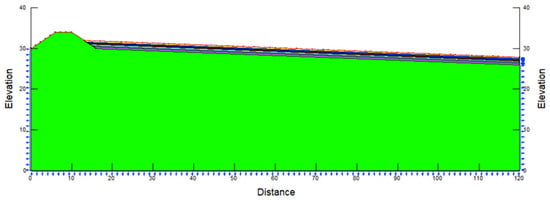
Figure 3.
Sketch of the simulation domain and boundary condition with six layers of tailing material. The green part is dam material, and the grey layers are tailing materials.
2.2. Material Properties
The dam material was assumed as isotropic elastic while the tailing materials as soft soil. Critical-state soil mechanics (CSSMs) principles were used for the tailings. The tailings characteristics and model parameters were taken from various studies, and the values of parameters of fresh tailings are listed in Table 1 [22,24,25], which may not directly relate to the characteristics of a particular tailing material. They have been taken to understand the effect of the tailings-deposition process on the dam stability. The parameter K0 is the coefficient of earth pressure at rest—the ratio of effective horizontal stress to effective vertical stress when there is no lateral deformation—and it is calculated. The parameters λ = 0.15 and κ = 0.03 were employed in the CSSM analysis. The volumetric water content and the hydraulic conductivity depend on the suction pression, and the relations for dam material and fresh tailings are shown in Figure 4 and Figure 5. The Van Genuchten function was employed for hydraulic conductivity estimation. Different values of hydraulic conductivity were also considered to investigate its influence. In this study, the ratio between the horizontal and vertical hydraulic conductivities Kx/Ky is assumed to be 1. Activation pore water pressure (APWP) for all materials is assumed to be zero. It must be noted here that these parameters are taken without considering any specific dam or materials and, hence, may not represent the actual properties.

Table 1.
Values of parameters of dam material and fresh tailings used in the simulations.
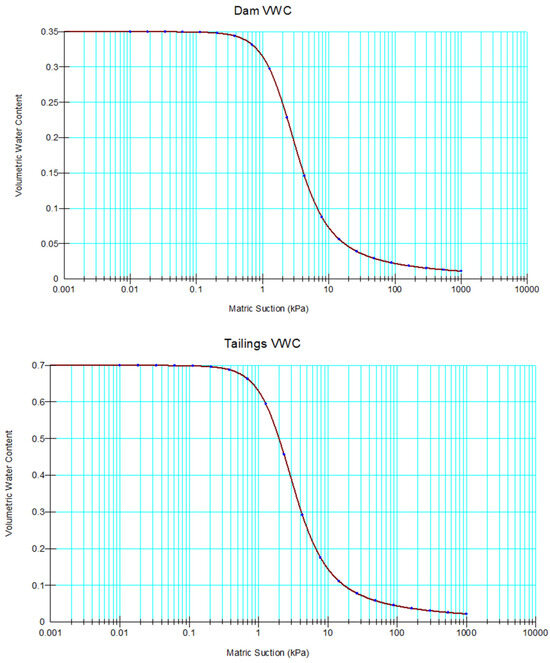
Figure 4.
The volumetric water content (%, VWC) with respect to metric suction (kPa) (top: dam material and bottom: fresh tailings material).
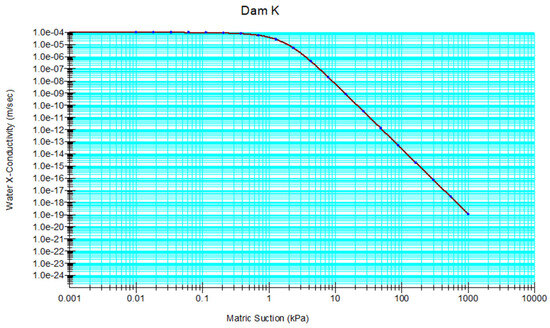
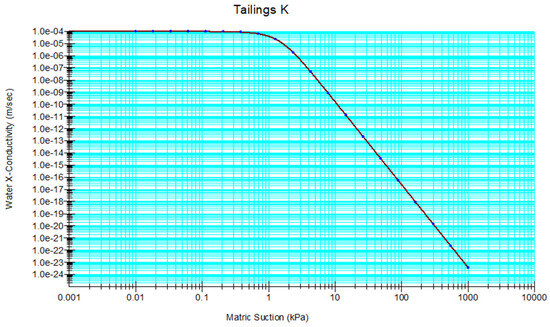
Figure 5.
The hydraulic conductivity (m/s) in a horizontal direction with respect to metric suction (kPa) (top: dam material and bottom: fresh tailings material).
Besides the fresh tailings whose properties are shown above, five more tailing materials were defined, identified as Tailings 1, Tailings 2, …, Tailings 5, and were used in the simulations (Table 2). All of them were assumed as soft soil, with the CSSM analysis. They were used for the layers as follows: When the first layer was added on the top of dam material, it consisted of fresh tailings, and the properties given above were used. When the second layer was added, it consisted of fresh tailings, and the layer beneath (or layer between the fresh tailings and dam material) had the properties of Tailings 1. When the third layer was added, it consisted of fresh tailings; the layer beneath the fresh tailings had properties of Tailings 1, and the layer beneath the Tailings 1 layer has properties of Tailings 2. This procedure recurs (iterates) for six layers. In this way, when all six layers were added, the layers from the top downwards to the dam material would have properties of fresh tailings, Tailings 1, Tailings 2, …, Tailings 5. Tailings 5 has been deposited for a longer time, and it has properties with stronger strength and lower porosity. In contrast, Tailings 1 has weaker strength and higher porosity. Values of some parameters of fresh tailings were taken for the other five materials, while some parameters had altered values. The parameters whose values were altered are shown in Table 2, together with their values for the different tailings.

Table 2.
Values of some parameters of settled tailings.
2.3. Boundary Conditions
For seepage analyses (SEEP/W), the seepage/drainage condition, with outwards water flux of 1.0 × 10−7 m3/s/m2, was applied on the two vertical surfaces and the bottom horizontal surface. Different flux values were also considered to investigate its effect. Zero water pressure was applied on the top surface of the fresh tailing layer. Thus, water can flow out of the simulation domain through the top surface of the fresh tailing and gather over the lower part of the tailing surface. But the effect of the gathered water was not considered. No flow condition was applied on the top surface and two slope surfaces of the embarkment of the dam. For deformation and stress analyses (SIGMA/W), the bottom of the domain was fixed in both horizontal and vertical directions, the two vertical sides were fixed in the horizontal direction, and the other surfaces were free of traction.
3. Simulation Results
Six deposition increments (layers) were simulated. For the first increment, a fresh tailing layer was added on top of the dam material. For the other deposition increments, a fresh tailing layer was added on top of the previously laid tailings, whose properties are different for each deposition increment.
For transient flow analysis, various simulation step times, duration times, and outwards seepage flux values on the vertical and bottom boundaries were tried. The value of 1.0 × 10−7 m3/s/m2 was chosen for the seepage flux on the vertical and bottom boundaries for the base simulation because it was found that for higher seepage flux (including 1.0 × 10−6 m3/s/m2), the simulations do not show reasonable results, even with a numerical instability problem. With the values of parameters specified above, for the first deposition increment, a transient effect occurs within six days, after which the distributions of water flux and water pressure do not change (noticeably). Thus, the settlement time for the first layer is six days. For the other deposition increments, the transient effect periods are around four days. Thus, six days were used as simulation duration period for all deposition increments. The settlement time of six days is much shorter than that Williams et al. [22] observed (twenty-eight days) for the stability of a tailing dam. It is noticed that although the distribution of water flux does not change after six days, there are higher water flux regions. The analysis is purely based on mechanical conditions; climate effect and evaporation were not considered in the simulations. A longer settlement time for each deposition increment, with water evaporation, would make the dam stabler.
For the first deposition increment, based on the pore water conditions from the seepage analysis, stabilities of the two slope surfaces at the upper part of the embarkment and the deformation and stresses in the domain were analysed using SLOPE/W and SIGMA/W, respectively. For the other deposition increments with a new layer, the pore water conditions and stresses from the simulations of the previous layer were taken as the initial conditions
3.1. Seepage Flow
Figure 6 and Figure 7a show the transient effects of water flux within six days for the first deposition increment. The maximum water flux is at the toe of the upstream slope surface of the embarkment or highest point of the tailing layer, around which a higher flux region forms and the water flows “downwards”. On day one, the water mostly moves downwards. On day two, a local higher flux region appears around the lowest point of the tailing layer. At the upper part of the tailing layer, the lower flux regions expand, and higher flux regions shrink with time (see Figure 6 and Figure 7a for one to six days). At the lower part of the tailing layer, the higher flux region expands, and the lower flux region shrinks with time. Outward velocity/flux vectors exist at the lower part of the tailing-layer surface, indicating that water could gather at the location. The maximum flux on the first day is 8.6 × 10−5 m3/s/m2, and it decreases with time. There is no noticeable difference between the distributions for day five and day six, indicating a settlement time of six days. The distribution pattern on the sixth day is very close to the result from a steady-state analysis with SEEP/W.
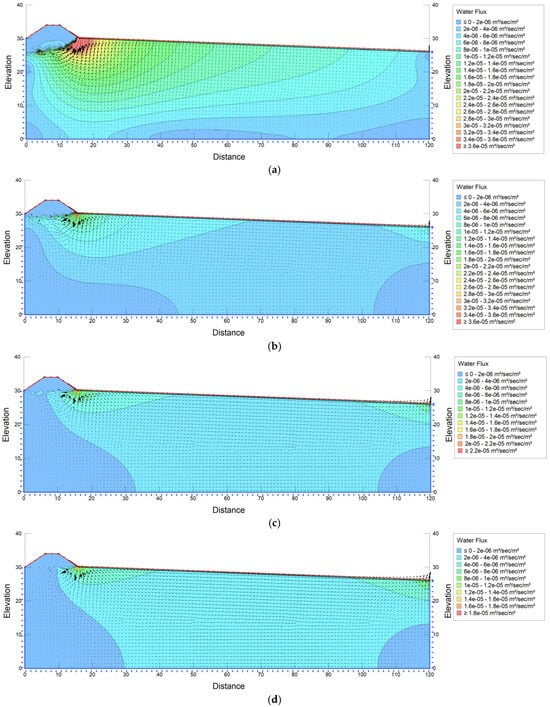

Figure 6.
SEEP/W model showing transient effect within six days of water fluxes for the first deposition increment at (a) day one, (b) day two, (c) day three, (d) day four, and (e) day five. Figure 7a is for day six.

Figure 7.
SEEP/W model showing water fluxes after six days transient condition with (a) one layer and (b) six layers of tailings.
Figure 7 and Figure 8 show water fluxes and pore water pressures on the sixth day of the first and the sixth increments from the simulations. The results for the second to fifth increments are given in Figure A1 and Figure A2 in the Appendix A. With more layers added, the flux distributions on the sixth day have very similar patterns for each layer addition. But with more layers added, the high flux region becomes larger. Higher flux regions exist at the lower part of the tailing layers, and there are velocity/flux vectors pointing outwards in the area—water flowing out the surface and gathering at the location. At the middle part of the layers, water flows along (parallel to) the layers. The transient effect period for the later layers is around four days.

Figure 8.
SEEP/W model showing pore water pressures after six days transient condition with (a) one layer and (b) six layers of tailings.
The pore water pressure at the bottom of the dam is the largest, and the maximum value increases when more layers are added (Figure 8 and Figure A2). It is noted that the pore water pressure at the top part of the dam embarkment is negative, and the lower boundary of the negative pore pressure region aligns with the top point of the surface of the newly added fresh tailing layer.
3.2. Stability of Slope Surfaces
The SLOPE/W provides the limit-equilibrium analysis of stability of the two slope surfaces at top of the embarkment for each deposition layer. The Morgenstern–Price method was used for the limit equilibrium analysis with a Mohr–Coulomb criterion for failure. The pore water pressures of the SEEP/W solutions were used in the stability analyses.
The possibility for slipping on the upstream slope surface of the top embarkment (from Left to Right in SLOPE/W term) was first studied. The initiation surface region for the slipping, or the region in which the slipping could start, was assumed to be the whole top of the embarkment. Figure 9 and Figure A3 show the slipping extension for each deposition increment for the six increments. The colour contours represent the values of total water head. Then, the slipping on the downstream slope surface of the top embarkment (from Right to Left in SLOPE/W term) was investigated. Again, the initiation surface region for the slipping was assumed to be the whole top of the embarkment. Figure 10 and Figure A4 show the slipping extension for the various deposition increments. The values of factors of safety are tabulated in Table 3.
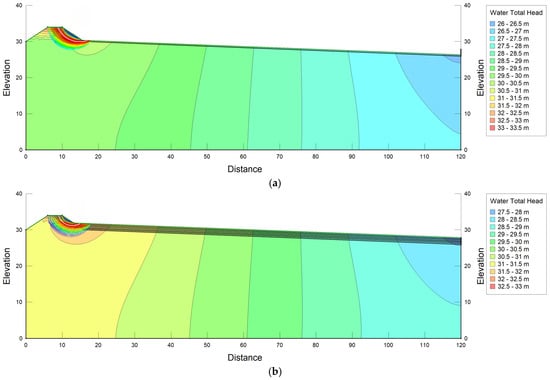
Figure 9.
SLOPE/W model showing the slipping extension of upstream slope surface (from Left to Right) with (a) one layer and (b) six layers of tailings.

Figure 10.
SLOPE/W model showing slipping extension of downstream slope surface (from Right to Left) with (a) one layer and (b) six layers of tailings.

Table 3.
Factors of safety for upstream and downstream slope surfaces and various deposition increments.
Stability of slope surface depends on various factors, such as material properties and the height of the surface. Generally, stronger and/or lower slope surface has larger factors of safety. As tailing layers are added in the model, the variation in the factor of safety for the upstream slope surface first decreases and then increases (Table 3). When the second layer is added as fresh tailing, the factor of safety is lower than that for the first layer. For the first layer, the dam material is beneath it. For the second layer, Tailing 1 material is beneath it. Material Tailing 1 is weaker than the dam material. This leads to decreased factor of safety. After the second layer, the height of the slope surface becomes dominant. As more layers are added, the height of the slope surface decreases, and the factor of safety increases.
On the other side of the embankment—downstream slope surface—the factor of safety is almost constant with the increase in the tailing-deposition height, except with the first deposition layer. This indicates that the increase in the tailing-deposition height does not have much mechanical effect on the downstream side of the dam embarkment. This could be because the width of the embarkment is relatively large. It should be noted that this is not a fully hydro-mechanical coupled model—fluid flow is not considered during the SLOPE/W stability analysis. Only the pore water pressure after the seepage analysis was completed was used. The results may be different with the fully coupled hydro-mechanical model.
3.3. Shear Stress Distribution
SIGMA/W was employed to analyse the stresses in the tailing dam, including dam material and tailings added at various increments. The dam material was assumed to be porous isotropic elastic, and the tailing material was soft soil with critical-state soil mechanics principles. The pore water pressure from the SEEP/W solutions were used in the stress analyses. Figure 11 and Figure A5 show distributions of the shear stress for various deposition increments after six days settlement of each increment. The shear stress around the two slopes at the top of the embarkment has different signs. Maximum positive shear stress is at the middle part of the downstream slope surface, while the maximum negative shear stress occurs at the toe of the upstream slope surface of the embarkment. A high (negative) shear stress area also occurs at the bottom of the domain. As the deposition increment increases (tailings height increases), the magnitude of shear stress decreases. This trend of stress decreasing agrees with the increase in the slope stability (increase in factor of safety) at the upstream surface of the embankment (Table 3).
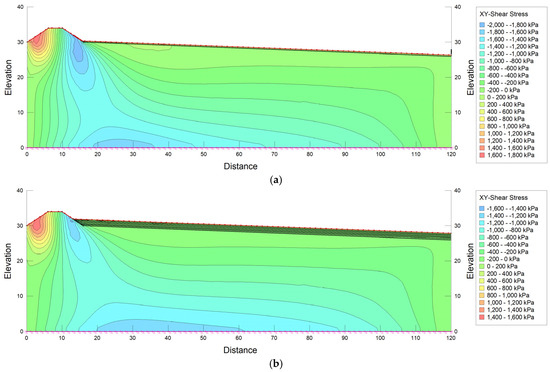
Figure 11.
SIGMA/W model showing shear stress (XY) distribution with (a) one layer and (b) six layers of tailings after six days settlement.
3.4. Effects of Layer Thickness
In this section, effects of tailings-increment thickness on the dam performance are investigated with two extra cases, thinner layers with 0.2 m thickness and thicker layers with 0.4 m thickness. The material properties of each deposition layer are all the same as those shown above. The simulation time for the 0.2 m thick layers is the same as above, six days. But for the 0.4 m thick layers, the simulation time is eight days for each layer, because it is expected that the transient effect period for the thicker layer would be longer.
The results show that the transient effect period for the first layer is around six days for both thicknesses, which is the same as that for 0.3 m thickness. For the other depositions, the transient period slowly decreases from five and a half days to four and a half days as the number of layers increases when the thickness is 0.2 m, while it is around four days for all the other layers if the thickness is 0.4 m, which is the same as that for 0.3 m thickness.
The water fluxes of the first increment and the sixth increment after settlement for six days are shown in Figure 12 for the two thicknesses. At the first deposition, the low water flux regions are very close for the three cases (Figure 7a and Figure 12a,b), while the maximum flux value decreases as the thickness of the layer increases. As more deposition increments are added, at the sixth increment, the low water flux region at the right bottom corner for 0.4 m thickness is larger than that for 0.2 m thickness, while the low flux region at the left boundary for 0.4 m thickness is smaller than that for 0.2 m thickness.
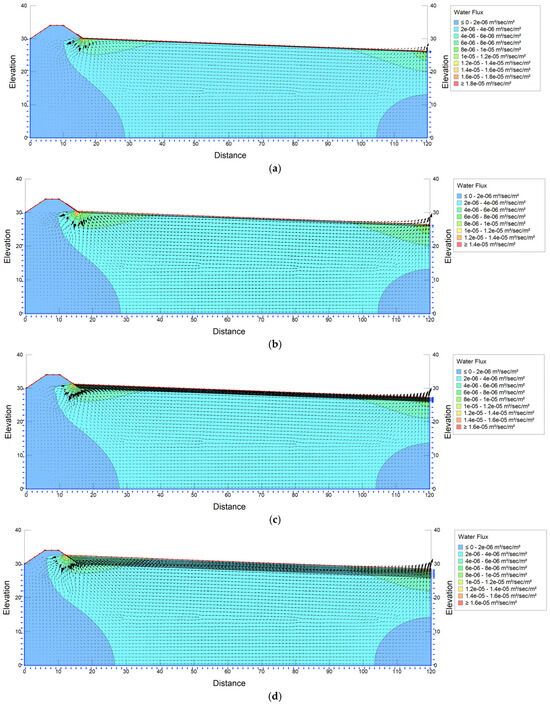
Figure 12.
Distributions of water flux in the tailing dam after six-days settlement of the first and sixth deposition increment for two thicknesses: (a) first increment of 0.2 m thick layers, (b) first increment of 0.4 m thick layers, (c) sixth increment of 0.2 m thick layers, (d) sixth increment of 0.4 m thick layers.
Table 4 and Table 5 show the factors of safety for the six deposition increments with the two thicknesses of the deposition layers. The thickness of the deposition layers does not affect the factor of safety of the downstream slope surface of the embarkment (slip from Right to Left). It does affect the factor of safety of the upstream slope surface: the thicker the layers, the higher the factor of safety. For all the three thicknesses studied, the factor of safety at the first layer is higher than that at the second layer; then, from the second layer, the factor of safety increases as the number of layers increases.

Table 4.
Factors of safety for upstream and downstream slope surfaces and various deposition increments with 0.2 m thick layers.

Table 5.
Factors of safety for upstream and downstream slope surfaces and various deposition increments with 0.4 m thick layers.
The factor of safety of the upstream slope surface at the second deposition increment is the smallest of the six depositions. Figure 13 shows the extensions of possible slipping of the two slope surfaces and water total head (the colour contours) with two thicknesses of the tailing layers for the second deposition.
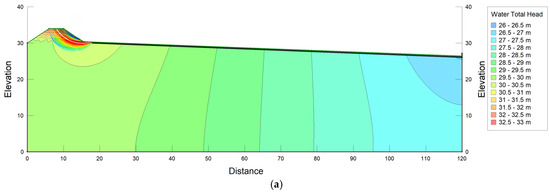
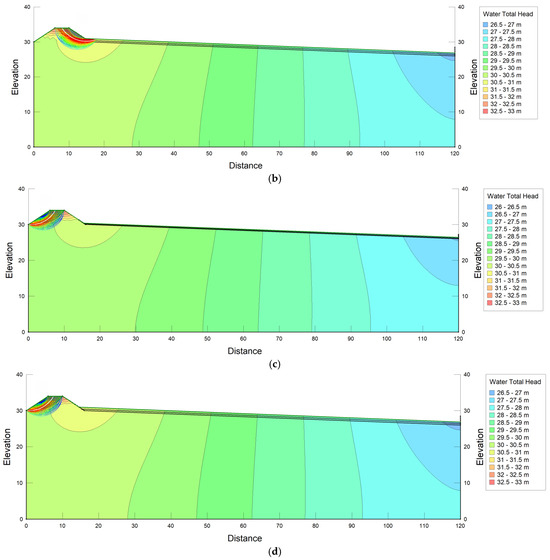
Figure 13.
The slipping extension on upstream and downstream slope surfaces for the second deposition with two thicknesses of layers: (a,c) with 0.2 m thickness, (b,d) with 0.4 m thickness; (a,b) for the upstream slope surface, (c,d) for the downstream slope surface.
Figure 14 shows the shear stress distribution for the two thicknesses of the tailing layers at the second and the sixth depositions after six-days settlement. At the second deposition, the thickness does not have much effect on the shear stress (Figure A5a and Figure 14a,b), except that the negative shear stress region at the toe of upstream slope surface is smaller for the 0.4 m layer than that for the 0.2 m layer. At the later deposition increment, the maximum magnitude of positive shear stress is not affected by the thickness, but the thickness does affect the negative shear stress magnitude and the distribution. The thinner layers have higher maximum negative shear stress than the thicker layer (Figure 11b and Figure 14c,d), and the higher negative shear stress is at the toe of the upstream slope surface of the top embarkment. These trends agree with variation in the factor of safety with the thickness observed above.
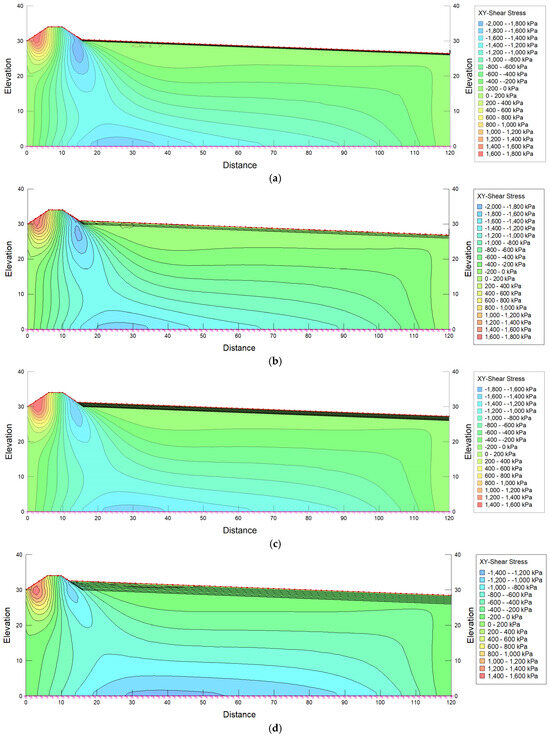
Figure 14.
Distributions of shear stress in the tailing dam for the second and sixth deposition with two thicknesses of 0.2 m and 0.4 m of layers: (a,c) with 0.2 m thickness, (b,d) with 0.4 m thickness; (a,b) for the second deposition, (c,d) for the sixth deposition.
3.5. Effects of Hydraulic Conductivity
Before the above values of hydraulic conductivity for dams and tailings were chosen, some higher conductivities were tried. It was found that the higher the conductivity, the shorter the transient effect period (settlement time). For the above hydraulic conductivity of 1.0 × 10−4 m/s at zero pressure, the transient effect occurs within six days for the first layer and around four days for the other layers. Another simulation was conducted with lower hydraulic conductivity of 1.0 × 10−5 m/s at zero pressure. At other pressure values, the conductivity is proportional to those of the case with 1.0 × 10−4 m/s at zero pressure. The seepage flux at the vertical and bottom boundaries was assumed to be 1.0 × 10−8 m3/s/m2. The low boundary flux was used because it was found that the results were not reasonable when the boundary flux was 1.0 × 10−7 m3/s/m2. The thickness of the layers was 0.3 m, and the other parameters have values shown in Section 3.1, Section 3.2 and Section 3.3.
For this set of conductivity and boundary flux, the transient effect occurs within forty-two days for the first layer and around twenty days for the other layers. Figure 15 shows the water flux distributions for the first layer at forty-two-days settlement and the sixth layer at twenty-eight-days settlement, which is the simulation time period for the second to the sixth layers. The higher flux region (≥2.0 × 10−7 m3/s/m2) shifts slightly towards the left as the layers are added.

Figure 15.
Distributions of water flux in the tailing dam after (a) forty-two-days settlement of the first deposition and (b) twenty-eight-days settlement of the sixth deposition, with 1.0 × 10−5 m/s hydraulic conductivity.
The factors of safety for the two slope surfaces are shown in Table 6. The values are basically the same as those in Table 3 (with very small differences for layers 5 and 6), indicating that the hydraulic conductivity does not affect the stability of slope surfaces very much.

Table 6.
Factors of safety for upstream and downstream slope surfaces and various deposition increments with 1.0 × 10−5 m/s hydraulic conductivity and 1.0 × 10−8 m3/s/m2 flux on the boundaries.
The settlement times from the simulations of the above cases are either shorter or longer than the twenty-eight days recommended in [22]. This indicates that hydraulic conductivity is one of the factors that control the settlement time. So, a case with a conductivity of 5.0 × 10−5 m/s and a flux of 1.0 × 10−7 m3/s/m2 on the vertical and bottom boundaries was simulated.
For this set of parameters, the settlement time for the first deposition increment is twenty-eight days and nine to eleven days for the other increments. Figure 16 shows the water flux distributions at the first and the sixth deposition increments. The more the tailing layers, the larger the high flux regions. The factors of safety for the two slope surfaces are basically the same as in Section 3.2, with the only slight difference being 1.856 compared to 1.855 for the upstream slope at the first layer.

Figure 16.
Distributions of water flux in the tailing dam after (a) twenty-eight-days settlement of the first deposition and (b) twenty-days settlement of the sixth deposition, with 5.0 × 10−5 m/s hydraulic conductivity and 1.0 × 10−7 m3/s/m2 flux on the boundaries.
3.6. Effects of Water Flux on Boundaries
The amount of water seeping through the boundaries is not known in the reality. In the above simulations, the water fluxes on the two vertical and bottom boundaries were specified as 0.1 or 0.2 percent of the hydraulic conductivities of the materials at zero pressure. Simulations show that when the boundary flux was 1 percent of the conductivity, the results were not reasonable, unrealistically high flux was predicted at a spot-on boundary. In this section, the effect of water flux on the three boundaries is investigated. Three extra cases of the boundary flux were investigated, with hydraulic conductivity of 1.0 × 10−4 m/s and layer thickness of 0.3 m as in Section 3.1, Section 3.2 and Section 3.3. The three boundary fluxes are 5.0 × 10−7 m3/s/m2 (larger than that in Section 3.1, Section 3.2 and Section 3.3—0.5 percent of hydraulic conductivity), 1.0 × 10−8 m3/s/m2 (the same as in Section 3.5, 0.01 percent of hydraulic conductivity) and no flow.
The settlement times for the layers for the three boundary fluxes are very close to each other and very close to those shown in Section 3.1. Therefore, the boundary flux has very limited effect on the settlement time. Figure 17 shows water flux distributions in the tailing dam with the first and the sixth layers for the three boundary fluxes. Boundary flux influences the distribution of the water flux in the dam, with a faster boundary flux leading to a larger high water flux region at the upper part of the tailing layers but a smaller high flux region at the lower part of the tailing layers. This effect disappears when the boundary flux is very low (comparing those for 1.0 × 10−8 m3/s/m2 and no flow conditions).

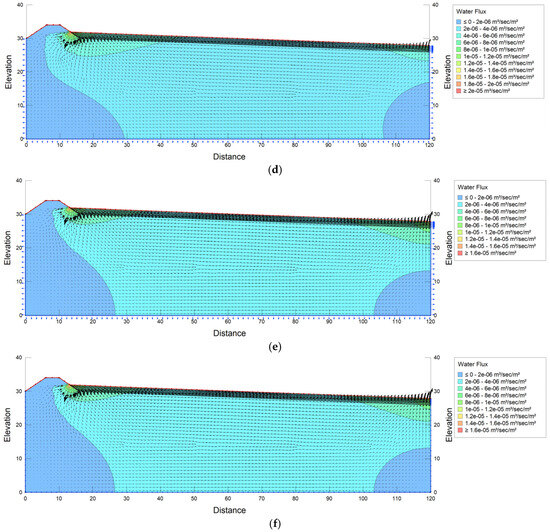
Figure 17.
Distributions of water flux in the tailing dam at the first deposition increment with boundary flux: (a) 5.0 × 10−7 m3/s/m2, (b) 1.0 × 10−8 m3/s/m2, (c) no flow, and at the sixth deposition increment with boundary flux (d) 5.0 × 10−7 m3/s/m2, (e) 1.0 × 10−8 m3/s/m2, (f) no flow.
It was found that the factors of safety for the two slope surfaces of the six deposition increments are the same when the boundary fluxes on the vertical and bottom boundaries are 5.0 × 10−7 m3/s/m2, 1.0 × 10−7 m3/s/m2, and 1.0 × 10−8 m3/s/m2, as shown in Table 3. When the vertical and bottom boundaries are impermeable (no flow), the upstream slope surface has higher, while the downstream slope surface has lower, factors of safety than those for permeable boundaries (Table 7).

Table 7.
Factors of safety for upstream and downstream slope surfaces and various deposition increments with no flow on the vertical and bottom boundaries.
4. Conclusions
The Geostudio’s software suits SEEP/W, SLOPE/W, and SIGMA/W were employed to investigate the response of tailings dams to a progressing deposition of a layer of fresh tailings on top of previously deposited tailing layers. Six deposition layers were considered. The layers were laid layer by layer, and each layer was allowed to settle for a certain time before another layer was laid on its top. The mechanical and hydraulic properties of the layers are different according to their settlement time. The effects of the thickness of the layers, hydraulic conductivity of materials and boundary seepage flux on stability and settlement time of each layer were investigated. With the values of the parameters and the particular model used in this paper, the following observations are noted:
- High water flux occurs in regions around the toe of the slope surface (upper part of tailing layers) and lower part of the tailing layers. The two bottom corner regions have the lowest water flux.
- For the upstream slope surface (towards the tailings material, Left to Right of SLOPE/W term) of the dam embarkment, when the second layer of tailings is deposited, the factor of safety is lower than that when the first layer of tailings was added. After the deposition of the second layer, the factor of safety increases as the number of layers increases. The reason for this non-monotonic change in the factor of safety may be that the first deposited tailing layer beneath the second layer is not as strong as the dam material, which covers the whole domain before tailing layers were deposited. After the deposition of the second layer, the height of the slope surface becomes the dominant factor. As more and more layers are added, the height of the slope surface decreases, leading to a higher factor of safety. On the downstream slope surface of the dam embankment, after the first layer, the factor of safety is almost constant as the tailing deposition height increases. This is because the size of the top part of the dam embarkment is relatively large.
- There are three high-shear-stress regions: one near the middle part of the downstream slope surface with positive shear stress value, one at the toe of the upstream slope surface of the dam embarkment, and the third one at the bottom of the dam region beneath the toe of upstream slope surface. The last two regions have negative shear stress. As the number of the deposition layer increases, the maximum shear stress decreases.
- The thickness of the deposited layers has effects on the factor of safety of the upstream slope surface of the dam embarkment. The thicker the layers, the larger the factor of safety. The thickness does not influence the stability of the downstream slope surface according to the simulations.
- Hydraulic conductivity is one of the factors that influence the settlement time of the tailing layers: The lower the conductivity, the longer the settlement time. Conductivity has very limited effects on the stability of the slope surfaces.
Author Contributions
Conceptualisation, M.K. and Q.Q.; methodology, M.K., J.S. and Q.Q.; validation, M.K., J.S. and Q.Q.; formal analysis, J.S. and M.K.; investigation, J.S. and M.K.; resources, M.K. and Q.Q.; data curation, J.S.; writing—original draft preparation, M.K. and J.S.; writing—review and editing, J.S., M.K. and Q.Q.; visualisation, J.S.; supervision, M.K. and Q.Q.; project administration, Q.Q.; funding acquisition, Q.Q. All authors have read and agreed to the published version of the manuscript.
Funding
This research received no external funding.
Data Availability Statement
Data would be available on request.
Acknowledgments
The authors are grateful to CSIRO Mine Geoenvironment Team’s strategy research funding, and to Andy Wilkins of CSIRO Minerals for his constructive suggestions for improvement of the paper.
Conflicts of Interest
The authors declare no conflicts of interest.
Appendix A
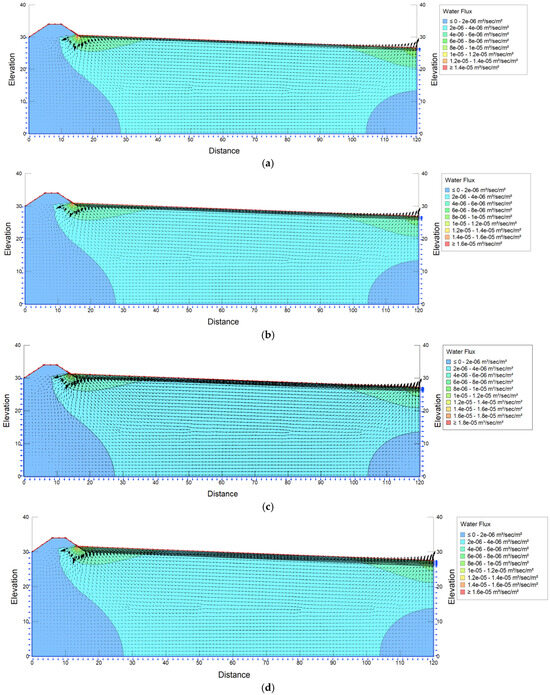
Figure A1.
SEEP/W model showing water fluxes after six days transient condition with (a) two layers, (b) three layers, (c) four layers, and (d) five layers of tailings.

Figure A2.
SEEP/W model showing pore water pressure after six days transient condition with (a) two layers, (b) three layers, (c) four layers, and (d) five layers of tailings.

Figure A3.
SLOPE/W model showing the slipping extension of upstream slope surface (from Left to Right) with (a) two layers, (b) three layers, (c) four layers, and (d) five layers of tailings.
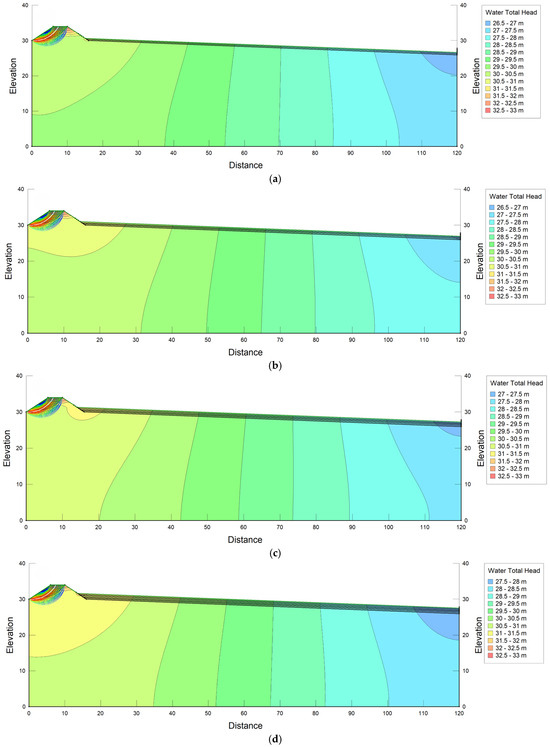
Figure A4.
SEEP/W model showing the slipping extension of upstream slope surface (from Right to Left) with (a) two layers, (b) three layers, (c) four layers, and (d) five layers of tailings.
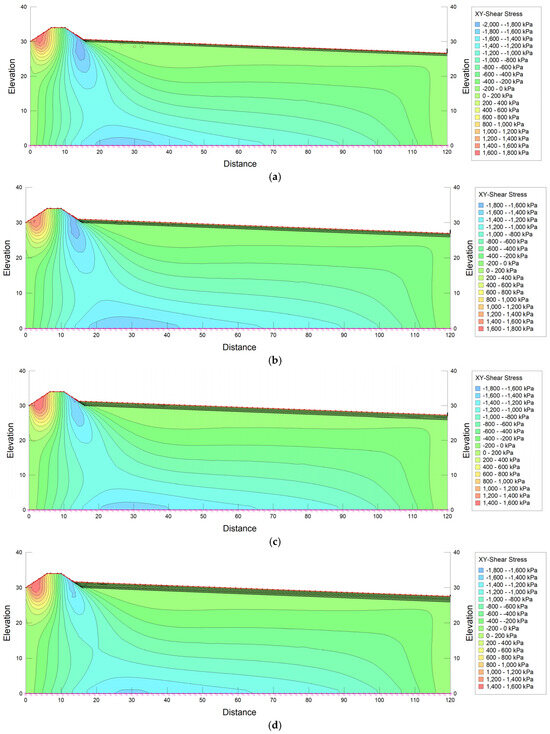
Figure A5.
SEEP/W model showing the shear stress (XY) distribution with (a) two layers, (b) three layers, (c) four layers, and (d) five layers, of tailings after six days settlement.
References
- Nelson, P.P. New directions for tailings management. In Proceedings of the Tailings and Mine Waste 2023, Vancouver, BC, Canada, 5–8 November 2023. [Google Scholar]
- Vale. Sand Produced by Vale Is a Solution to Sand Sustainability and Mine Tailings Reduction, According to Universities. 2022. Available online: https://www.vale.com/w/sand-produced-by-vale-is-a-solution-to-sandsustainability-and-mine-tailings-reduction-according-to-universities (accessed on 30 October 2024).
- Guo, L.; Peng, X.; Wang, Q.; Zhao, Y.; Xu, L.; Wu, S. Research progress on carbon dioxide mineralization sequestration technology by tailings. Green Smart Min. Eng. 2024, 1, 307–321. [Google Scholar] [CrossRef]
- INAP (The International Network for Acid Prevention). Development of the Global Acid Rock Drainage Guide. 2024. Available online: http://www.gardguide.com/index.php/Chapter_4 (accessed on 17 October 2024).
- Clarkson, L.; Williams, D. An overview of conventional tailings dam geotechnical failure mechanisms. Min. Metall. Explor. 2021, 38, 1305–1328. [Google Scholar] [CrossRef]
- Geppetti, A.; Facciorusso, J.; Madiai, C. Tailings dams numerical models: A review. In Proceedings of the 7th World Congress Civil, Structural and Environmental Engineering (CSEE’22), Lisbon, Portugal, 10–12 April 2022. [Google Scholar] [CrossRef]
- Ma, H.T.; Zhang, Y.H. Physical modeling of tailings dams in China: A review. J. Min. Sci. 2022, 58, 548–560. [Google Scholar]
- Clarkson, L.; Williams, D. Critical review of tailings dam monitoring best practice. Int. J. Min. Recl. Environ. 2020, 34, 119–148. [Google Scholar] [CrossRef]
- Clarkson, L.; Williams, D.; Seppälä, J. Real-time monitoring of tailings dams. Georisk Assess. Manag. Risk Eng. Syst. Geohazards 2021, 15, 113–127. [Google Scholar] [CrossRef]
- Bella, G.; Freire, C.; Lameiras, F.; Giani, M. Numerical investigation on tailing dams stability: A preliminary, parametric analysis of some key factors. In Proceedings of the 8th World Congress on Civil, Structural and Environmental Engineering (CSEE’23), Lisbon, Portugal, 29–31 March 2023. [Google Scholar]
- Finn, W.D.L.; Emergy, J.J.; Gupta, Y.P. Liquefaction of large samples of saturated sand on a shaking table. In Proceedings of the 1st Canadian Conference on Earthquake Engineering, Vancouver, BC, Canada, 25–26 May 1971; pp. 97–110. [Google Scholar]
- Finn, W.D.L.; Pickering, D.J.; Bransby, P.L. Sand liquefaction in triaxial and simple shear tests. J. Soil Mech. Found. Div. 1971, 97, 639–659. [Google Scholar]
- Finn, W.D.L. Soil dynamics-liquefaction of sands. In Proceedings of the International Conference on Microzonation, Seattle, WA, USA, 30 October–3 November 1972; Volume 1, pp. 87–111. [Google Scholar]
- Martin, G.R.; Finn, W.D.L.; Seed, H.B. Fundamentals of liquefaction under cyclic loading. J. Geotech. Eng. Div. 1975, 101, 423–438. [Google Scholar]
- Byrne, P.M.; Park, S.S.; Beaty, M.; Sharp, M.K.; Gonzalez, L.; Abdoun, T. Numerical modeling of dynamic centrifuge tests. In Proceedings of the 13th World Conference on Earthquake Engineering, Vancouver, BC, Canada, 1–6 August 2004. [Google Scholar]
- Badiozamani, M.M.; Beier, N. Estimating the potential differential settlement of a tailings deposit based on consolidation properties heterogeneity. Appl. Sci. 2022, 12, 6206. [Google Scholar] [CrossRef]
- Amodio, A.; Zhou, H.; Boylan, N. FLAC Based Modelling of Tailings Deposition and Consolidation. In Applied Numerical Modeling in Geomechanics; Itasca International, Inc.: Minneapolis, MN, USA, 2020. [Google Scholar]
- Jahanbakhshzadeh, A.; Aubertin, M. Effective Stress Analyses to Assess the Stability of Progressively Raised Upstream Dikes for Tailings Impoundments with Waste Rock Inclusions. Geotech. Geol. Eng. 2024, 42, 3193–3212. [Google Scholar]
- Fu, B.T.; Pei, J.J.; Ji, H.J. Numerical simulation of three-dimensional seepage field in a tailing pond under multiple operating conditions. Sci. Rep. 2024, 14, 28027. [Google Scholar]
- Zheng, J.; Bonin, M.D.; Mohammad, K.; Nousiainen, J.; Masengo, E.; Shaigetz, M.L. Stability analysis of tailings dams using limit equilibrium and finite element methods. Proc. Inst. Civ. Eng.-Geotech. Eng. 2024, 1–13. [Google Scholar] [CrossRef]
- Nguyen, N.D.; Pabst, T. Numerical Study of consolidation of Slurry tailings considering continuous update of Material Properties. Geotech. Geol. Eng. 2024, 42, 3251–3267. [Google Scholar]
- Williams, D.J.; Price, G.; Li, H. Assessing the flowability of bauxite tailings at East Weipa, Queensland. In Proceedings of the 14th International Seminar on Paste and Thickened Tailings (Paste 2011), Perth, Australia, 5–7 April 2011; pp. 367–379. [Google Scholar]
- GeoStudio. Available online: https://www.seequent.com/products-solutions/geostudio/ (accessed on 25 November 2024).
- Smith, L. Hydrogeology and Mineral Resource Development; Groundwater Project: Guelph, ON, Canada, 2021; 67p, ISBN 978-1-77470-002-0. [Google Scholar]
- Demoz, A. Geotechnical properties determination of thickened fluid fine tailings. Geotech. Geol. Eng. 2022, 40, 1887–1898. [Google Scholar]
Disclaimer/Publisher’s Note: The statements, opinions and data contained in all publications are solely those of the individual author(s) and contributor(s) and not of MDPI and/or the editor(s). MDPI and/or the editor(s) disclaim responsibility for any injury to people or property resulting from any ideas, methods, instructions or products referred to in the content. |
© 2025 by the authors. Licensee MDPI, Basel, Switzerland. This article is an open access article distributed under the terms and conditions of the Creative Commons Attribution (CC BY) license (https://creativecommons.org/licenses/by/4.0/).